How does concrete strength affect fire resistance?
Abstract
At first, it may seem contradictory that higher concrete strengths can degrade fire resistance of building structures. However, if the strength of the concrete exceeds an upper limit, the probability of concrete surfaces becoming detached increases. During prefabrication, structural elements are often produced with greater strength than planned. Higher concrete strengths generally do not cause a decrease in load-bearing capacity, but can be a serious problem when sizing for fire load. During the research, two prefabricated elements were tested: a TT panel and a single-wall panel. During the test, a reference element (currently in production) and a component made with a
modified concrete composition were compared. In the modification, structures were tested by adding plastic fibers to prevent the layering of concrete. As a result of our experiments, we recommend making stricters standards. It has been proven that in order to ensure the fire safety of reinforced concrete structures, it is necessary to require the addition of plastic fibers even in the lower concrete strength class and to introduce an upper strength limit from the aspect of fire safety.
References
Kordina, K (1997): Über das Brandverhalten punktgestützter Stahbetonbalken, Deutscher Ausschuss für Stahlbeton, Heft 479, ISSN 0171-7197, Beuth Verlag GmbH, Berlin
Khoury, G. A., Grainger, B. N, Sullivan P. J. E (1985): Transient thermal strain of concrete: literature review, conditions within specimen and behaviour of individual constituents, Magazine of Concrete Research, Vol 37, No. 132
Schneider, U., Lebeda, C. (2000): Baulicher Brandschutz, ISBN 3-17-015266-1 W. Kohlhammer GmbH, Stuttgart
Waubke, N. V. (1973): Über einen physikalischen Gesichtspunkt der Festigkeitsverluste von Portlandzementbetonen bei Temperaturen bis 1000°C-Brandverhalten von
Bauteilen, Dissertation, TU Braunschweig
Hinrichsmeyer, K. (1987): Strukturorientierte Analyse und Modellbeschreibung der thermischen Schädigung von Beton, Heft 74 IBMB, Braunschweig
Hertz, K.D. (2005): Limits of spalling of fire-exposed concrete, Fire Safety Journal, Volume 38, Issue 2, 2003, Pages 103-116, ISSN 0379-7112, http://dx.doi.org/10.1016/S0379-7112(02)00051-6.
Hertz K.D. (2003) Limits of spalling of fire exposed concrete, Fire Safety Journal, 38 (2), pp. 103-116
Kodur V.K.R., Wang T.C., Cheng F.P. (2004) Predicting the fire resistance behaviour of high strength concrete columns,Cement & Concrete Composites, 26 (2), pp. 141-153
Kalifa P., Menneteau F.D., Quenard D.(2000) Spalling and pore pressure in HPC at high temperature Cement and Concrete Research, 30 (12), pp. 1915-1927
Dwaikat, M.B. & Kodur, V.K.R. Fire Technol (2010) 46: 251. https://doi.org/10.1007/s10694-009-0088-6
P. Kalifa, G. Chene, C. Galle High-temperature behavior of HPC with polypropylene fibers: from spalling to microstructure, Cement & Concrete Composites, 31 (10) (2001), pp. 1487-1499
Høj, N., P. (2005): Fire Desin of Concrete Stuctures, Proceedings of fib symposium on Keep concrete attractive, (edited by Gy. L. Balázs, A. Borosnyói), 23-25 May 2005 Budapest, pp.: 1097-1105
Mörth, W., Haberland Ch., Horvath J., Mayer A.,. (2005): Behaviour of Optimized Tunnel Concrete with Special Aggregates at High Temperature, Proceedings of Central Europan Congress on Concrete Engneering 8.-9. Sept. 2005, Graz, pp.: 41-50Schneider, U., Lebeda, C. (2000): Baulicher Brandschutz, ISBN 3-17-015266-1 W. Kohlhammer GmbH, Stuttgart
Walter, R., Kari H., Kutserle W., Lindlbauer W. (2005): Analysis of the Load-bearing Capacity of Fibre Reinforced Concrete During Fire, procedings of Central Europan Congress on Concrete Engneering, 8.-9. Sept. 2005 Graz, pp.: 54-59
Eurocode 2 (2004) prEN1992-1-2: design of concrete structures. Part 1–2: general rules––structural fire design. Comité Europeén de Normalisation (CEN), Brussels
Richtlinie (2005) : “Erhöhter Brandschutz mit Beton für unterirdische Verkehrsbauwerke“ (2005) Wien ÖVBB
Silfwerbrand, J. (2004): Guidelines for preventing explosive spalling in concrete structures exposed to fire, Proceedings of Keep Concrete Attractive, Hungarian Group of fib. 23-25 Mai 2005, Budapest University of Technology and Economics, Budapest: 2005, pp. 1148-1156. - ISBN 963 420 837 1
Zheng W., Li H., Wang Y. (2012): „Compressive behaviour of hybrid fiber-reinforced reactive powder concrete after high temperature”, Materials and Design, No. 41, pp. 403–409.
MSZ prEN 1365-2:2012
Eurocode 1 (2004) prEN1991-1-2:…... Comité Europeén de Normalisation (CEN),
Brussels
MSZ EN 206
MSZ 4798




